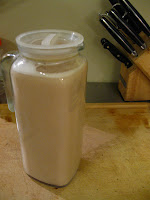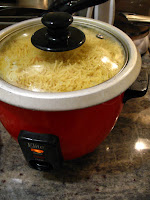 Not pictured: Richard
Not pictured: RichardAfter enjoying the
purslane with potatoes in green sauce that we made last week, we decided that we needed to make the most of tomatillos while they were in season. This led to the decision to re-make a delicious roasted tomatillo salsa that we first made last summer. But of course, salsa needs something to go on, so we decided to make chiles rellenos (stuffed poblano chilies). This called for making rice - which of course must be yellow rice, which we didn't have but decided we could make - and of course beans. That inspired us to try out the "frijoles borrachos" (drunken beans) recipe we'd been mulling over for quite a while. ....Needless to say, partway into this ambitious endeavor we realized it was time to have an impromptu dinner party.
Frijoles borrachos are beans slow-cooked with Mexican beer, along with other seasonings. We used some black beans that we got from our CSA last winter but never quite got around to:

The tomatillos were a multicolored bunch - mostly green, but with some yellows and purples. For the salsa, they're put under the broiler until the skins are blackened (this can also be done in a cast-iron skillet), then skinned and blended with jalapenos, onion, and garlic (all blackened as well). Roasting brings out a completely different flavor from tomatillos than does boiling, as in the purslane dish we made last week.

Here are the chiles rellenos being....relleno'd:

Ok, our dinner involved a lot of blackening - these were blackened and skinned as well, then de-seeded and de-veined, and stuffed with cheese for a final bake. Lizz's hands burned for the next 24 hours from touching the chili veins, but it was worth it.

Once we had invited people over, we realized it would probably be a good idea to have a drink to serve them. Ambitiously, we decided to make horchata, the delicious Mexican rice drink. The recipe we followed called for pulverizing some rice, then soaking it in water with a stick of cinnamon, and then blending it in several stages while adding water. Finally it gets strained and sugar is added to sweeten. It came out pretty well, although probably a finer mesh strainer would have given it a better texture.
Meanwhile the salsa and beans simmered away:

Though we used to buy it in premixed packets, yellow rice isn't honestly too hard to make: you start with white rice and cook it with a generous pinch of saffron, some cumin, some garlic powder (if you have or like garlic powder), and a coloring agent - usually annato seeds, but turmeric works too.

Our friends Manasi and Richard kindly brought over a batch of freshly-made guacamole, as you can see here:

It was quite a spread...if we do say so ourselves.



